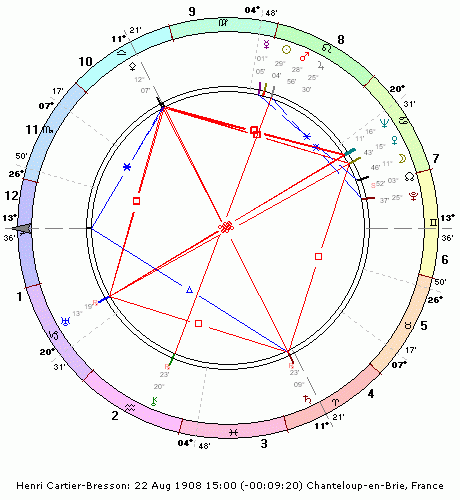
To promote and celebrate my new monthly column in Digital Photo Pro magazine, I am planning to extend my analysis of all matters photographic in the astrology and prove that it is possible to identify both the ability and the opportunity to carry on a photographic career by looking in detail at specific cases. I plan then to provide a monthly insight into an interesting case. Intriguingly, it is often possible to ascertain the specific styles or disciplines of photography in which an individual might excel simply by looking at the various delineations. As an opening case then, I will study the astrology of a pioneer in the field of photography, Henri Cartier-Bresson, who is recognised as the inventor of photo-journalism and the first to make candid portraiture viable. His story contains much to interest both the astrologer and the photographer, he seemed destined to spend his efforts in the family textile business, but took the unusual decision to become an artist instead, he began by painting and then became serious about photography but much of his background as a student of painting gave him a good grounding in both composition and structure which he was later to use to good effect in his photographic career. His conversion to photography was similar to a religious epiphany and he said of that moment “I suddenly understood that a photograph could fix eternity in an instant.” It was the allure of attempting to capture this elusive eternal quality that drove him from that point on.
The young Henri acquired his first serious camera, a Leica with a 50mm lens which he used extensively for the remainder of his life; he loved its compactness, its anonymity and the way it allowed him to prowl “the streets all day, feeling very strung-up and ready to pounce, ready to ‘trap’ life.” He travelled the world in search of this elusive moment of “reality” that he so craved to immortalise and his first exhibition was held at the Julien Levy Gallery in New York in 1932, and subsequently in Madrid. Cartier-Bresson’s first photojournalist photos to be published came in 1937 when he covered the coronation of King George VI, for the French weekly Regards. He focused on the new monarch’s adoring subjects lining the London streets, and took no pictures of the king. His photo credit read “Cartier,” as he was hesitant to use his full family name.

His chart contains some deeply telling configurations. Whenever we look to the vocation – the life calling – we look to the midheaven, here in Libra, which of course is the most classically ‘artistic’ of the signs and is certainly the most attuned to form and aesthetic harmony. The midheaven ruler is found in the 7th, in Cancer and partile conjunct to Neptune, the planet which rules photography. Normally any conjunction of Venus and Neptune gives a mystical leaning, a sensitivity to art and an artist’s appreciation for the sublime and all of these themes are strongly resonant in Cartier-Bresson’s work and his commentary about his motivations; about this desire to “fix eternity.”
More intriguing still is the near partile conjunction of Pallas to the Midheaven which tells us that his greatest competence was in applying his unmatched competency in judging form to his vocational objectives; his career then, his artistic sense is his greatest strength; here is a man who was born to succeed. The Venus-Neptune conjunction is especially interesting when you consider the sign and house placement; here is a need to demonstrate his sensitivity to family, tribal and national issues, to depict human relationships but to divest them of their formality, his pictures convey that sense of intimacy and familiarity that almost invites us to be in the family of their subjects; we feel included, accepted, we catch a glimpse of the most intimate faces of others.

Furthermore, the partile conjunction of Sun and Mars configured with royal Regulus tells of an opportunity to gain rank and favour through great leaders and royalty; it is therefore no surprise that his first assignment was to capture scenes of the people of Britain celebrating the coronation of their king for a French readership. This speaks keenly to the issues of Venus and Neptune, Cancer and Regulus combined. See too how the grand cross contains elements of pioneering via a break with convention (Uranus in Capricorn), artistic sensitivity to the sublime and use of photography as art (Venus conjunct Neptune), an obsession with gaining respect (Saturn in Aries, stressed, in fall and traditionally peregrine) for his ideas, and unparalleled ability in his career (Pallas conjunct MC), which when considered as a whole create a powerful energy construct that could easily have left him paralysed by antagonistic and incompatible predilections, and yet somehow, he found the blend, the divine mix and changed the face of photography forever.
(Help with finding your unparalleled excellence as a photographer, or in any other career, can be found here.)




Very good analysis.
Hi there, I know a photographer with MC in Libra and Venus in the 7th house, just like in HCB’s case. Except his Venus is sesquisquare Neptune. Still, an amusing coincidence.